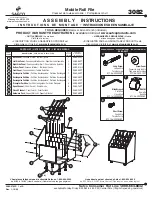
WavePro 7Zi
333
WP700Zi-OM-E-RevA
Where:
x
Equalized – applies a low pass filter with boost to the input data. This should not be used if the input data is
already equalized (filtered).
x
Leveled – Applies the filter (if the input data is raw RF) and then subtracts the sliced threshold from it.
x
Sliced – This is the output of the slicer. It is similar to Leveled except the amplitude of each pulse is
normalized to “1” and “0.”
x
Threshold – this waveform comprises the low frequency components of the original signal.
x
Extracted CLK – the sliced data is passed through a PLL and the recovered clock signal is produced.
Filtering
A low-pass filter that removes high-frequency noise and provides equalization is needed for the newer optical
recording systems (e.g., DVD). In the DVD read-only and recordable specifications are given the frequency
characteristics of the low pass filter (LPF) and equalizer (EQ) as a graph. The combination of these must meet
within 1 dB below 7 MHz, and it is recommended to meet it up to 10 MHz. Also, group delay variation for
frequencies </= 6.5 MHz must be >/= ±3 ns, and gain at 5.0 MHz minus gain at 0 Hz must be 3.2 ±0.3 dB. For the
LPF, it gives an example implementation to achieve these characteristics as a 6th order Bessel filter with a cutoff
frequency fc (-3dB) = 8.2 MHz, and an example for the EQ is a three-tap transversal filter.
The OData function implements the 6th order Bessel filter as a FIR filter to provide the low-pass filter capability.
The number of coefficients of the FIR depends on the ratio between the cutoff frequency fc and the sample rate
fs. For a 1x DVD with an fc of 8.2 MHz, sampled at 500 MS/s, approximately 220 taps are required. Sampling at 1
GS/s is about twice that. Ideally, the sampling rate should be 10 to 20 times the clock rate. For a 1x DVD with a
clock period of 37 ns, the sample rate should be 500 MS/s.
The three-tap equalization filter (EQ) is applied to the data after it has been low-pass filtered. The three samples
input to the EQ are not adjacent; they are at 0 and ±2T, where T is a 1/channel bit rate.
Because the spacing in DSO samples depends on data rate and sample rate, T is likely to be a non-integer
number of samples. In this case, interpolation is used to find the values at -2T and +2T.
Содержание DDA 7 Zi series
Страница 1: ...Operator s Manual WavePro SDA and DDA 7 Zi Series Oscilloscopes ...
Страница 2: ... L R R H HUD RU D D ...
Страница 41: ...Operator s Manual WP700Zi OM E RevA 40 The detachable WavePro Zi front panel ...
Страница 376: ...WavePro 7Zi 375 WP700Zi OM E RevA Absolute Offset Relative ...
Страница 439: ...Operator s Manual WP700Zi OM E RevA 438 ...
Страница 440: ...WavePro 7Zi 439 WP700Zi OM E RevA ...
Страница 544: ...Thank you for purchasing a WavePro SDA or DDA 7 Zi Oscilloscope ...
















































